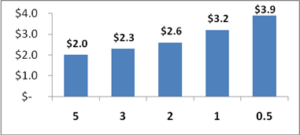Sales Engineers Enable Higher Sales Per Rep
Companies often deploy Sales Engineers (SEs) to help demo and customize technical solutions. SEs are considered overlay as they typically are tied to one or more Rep quotas. Deploying SEs is therefore an added cost to the sales force. Are they worth it? To find out, we evaluated the sales rep productivity of 100 sales forces in our benchmark database. As expected, companies with higher SE to rep ratios have higher revenue per rep. On average, sales forces with a 1:5 ratio (1 SE for 5 reps) have revenue per rep of $2M, while sales forces with a 1:1 ratio average $3.2M per rep. (see chart below).
Does this mean you should hire more SEs? The answer depends on a variety of factors. To determine the optimal ratio of SEs to reps the following factors should be evaluated:
- the complexity of the product or solution
- the maturity of the product or solution
- the bandwidth of the sales rep (how many other products or solutions do they sell or represent?)
- the length of the sales cycle
- the typical deal size
- the size of the customer
- the SE role (pure pre-sales or hybrid pre/post-sales responsibilities)
For complex solutions sold to top Enterprise customers, sales reps are typically paired 1 to 1. Large global account reps may even have multiple SEs supporting them. However mid-market reps are typically paired 1:2 or 1:3, and certain solutions may only call for one SE for every 5 or 6 reps. Best practice companies evaluate their SE roles, headcount, and deployment ratios on a regular basis, making sure that the investment in these highly skilled resources is realizing the desired return.
Whether you’re selling to top Enterprise customers, managing mid-market reps, or dealing with global accounts, Alexander Group provides tailored solutions. Contact us to get started today.
